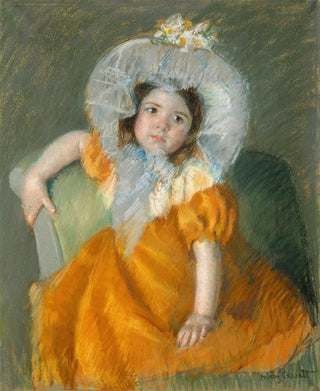Art print | Margot in orange dress - Mary Cassatt


View from behind

Frame (optional)
In the captivating world of Impressionist art, the artwork "Margot in an Orange Dress" by Mary Cassatt stands out for its elegance and sensitivity. Painted at the end of the 19th century, this canvas not only showcases the undeniable talent of the artist but also her commitment to depicting women and children. Cassatt, a prominent figure of her time, manages to capture a rare intimacy through her subject, Margot, a young girl dressed in a vibrant orange dress that immediately draws the eye. This piece is much more than a simple representation; it evokes a world filled with softness and tenderness, where each brushstroke seems to tell a story.
Style and uniqueness of the artwork
Mary Cassatt's style is characterized by bold use of colors and exceptional mastery of light. In "Margot in an Orange Dress," the vibrant shades of orange blend harmoniously with softer hues, creating a striking contrast that highlights the innocent face of the child. The composition is carefully thought out, with a blurred background directing the viewer's gaze toward Margot, thus emphasizing her importance in the scene. Cassatt employs quick, fluid brushstrokes, typical of Impressionism, to bring her subject to life while maintaining a certain delicacy. This painting transcends a simple portrait to become a true ode to childhood, where joy and innocence combine in a fleeting moment of grace.
The artist and her influence
Mary Cassatt, born in 1844 in Pittsburgh, is one of the few women to have succeeded in establishing herself in the art world at a time when female artists were often marginalized. Influenced by her friendship with Edgar Degas and her immersion in the Impressionist circle, she developed a unique style that is her own. Cassatt consistently highlighted themes related to women's lives, motherhood, and childhood, offering a novel and personal perspective on subjects often overlooked by her contemporaries. Her work not only enriched the Impressionist movement but also paved the way for future generations of women artists, making her a

Matte finish

View from behind

Frame (optional)
In the captivating world of Impressionist art, the artwork "Margot in an Orange Dress" by Mary Cassatt stands out for its elegance and sensitivity. Painted at the end of the 19th century, this canvas not only showcases the undeniable talent of the artist but also her commitment to depicting women and children. Cassatt, a prominent figure of her time, manages to capture a rare intimacy through her subject, Margot, a young girl dressed in a vibrant orange dress that immediately draws the eye. This piece is much more than a simple representation; it evokes a world filled with softness and tenderness, where each brushstroke seems to tell a story.
Style and uniqueness of the artwork
Mary Cassatt's style is characterized by bold use of colors and exceptional mastery of light. In "Margot in an Orange Dress," the vibrant shades of orange blend harmoniously with softer hues, creating a striking contrast that highlights the innocent face of the child. The composition is carefully thought out, with a blurred background directing the viewer's gaze toward Margot, thus emphasizing her importance in the scene. Cassatt employs quick, fluid brushstrokes, typical of Impressionism, to bring her subject to life while maintaining a certain delicacy. This painting transcends a simple portrait to become a true ode to childhood, where joy and innocence combine in a fleeting moment of grace.
The artist and her influence
Mary Cassatt, born in 1844 in Pittsburgh, is one of the few women to have succeeded in establishing herself in the art world at a time when female artists were often marginalized. Influenced by her friendship with Edgar Degas and her immersion in the Impressionist circle, she developed a unique style that is her own. Cassatt consistently highlighted themes related to women's lives, motherhood, and childhood, offering a novel and personal perspective on subjects often overlooked by her contemporaries. Her work not only enriched the Impressionist movement but also paved the way for future generations of women artists, making her a






